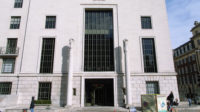As long as we’ve had cities, we’ve built ways to keep people out of them. In early times, guard towers and pointed palisades kept wanderers away and enemies at bay. Today, urban designers employ similarly defensive measures throughout the public realm, in subtler and more nuanced ways.
Increasingly, elements of “hostile architecture” are found in places meant to be accessible and inclusive, such as public parks, city streets, and hospitals. While the intention of these features is often rooted in durability and safety, the effects can be more wide-reaching, says Cara Chellew, a research administrator at York University in Toronto and an advocate for public spaces. “It’s sneaky, because a lot of features seem benign and innocent, but are actually used for other reasons,” she says.
For instance, benches divided by armrests not only make it more difficult for people (homeless or otherwise) to lie down and rest, they present a challenge for people who need more room to sit. Humans don’t naturally sit in a tight row like pigeons on a wire; we congregate, spread out, or stagger, and need space to do so. Anti-vagrancy bars on benches create obtrusions that can be hard to navigate around. Metal studs on curbs meant to deter skateboarders are just as likely to trip pedestrians or block passage of those in wheelchairs.
But Chellew acknowledges that not all examples of defensive design (the “less sensationalized” term she prefers to use) are hostile.
Ken Greenberg, an urban planner who first conceived of the Bentway, a public space under the busy Gardiner Expressway in Toronto, tells RECORD that the project began with the question, "How do we connect to and best serve the needs of the population?" Since the area has long been a popular location for skateboarders, designers from landscape architecture firm Public Work included benches with metal lips able to withstand wear-and-tear of that activity—a decision that acknowledges and anticipates different potential uses and users of the space, while addressing questions of long-term durability.

Photo © Albert Vecerka
Defensive design measures can also be employed to protect visitors and natural areas.
Thomas Balsley, a principal of landscape architecture firm SWA/Balsley, has worked on public spaces in New York City for more than 35 years. Collaborating with Weiss/Manfredi, his firm recently completed Hunter’s Point South Park, an 11-acre project in Queens. Balsley said many of the park’s main draws (which include trails, playgrounds, a dog park, and sport fields) are oriented around a core park pavilion, a canopy, and a water taxi plaza. This plan helps keep most visitors within certain boundaries for their own safety, and to protect the landscape and park ecosystem as a whole.
Architect Marion Weiss of Weiss/Manfredi also notes that the waterfront site required some defensive components to withstand the elements. “For us, the dual challenges of creating a welcoming public park that also addresses flooding lead us to design a perimeter with both ‘soft’ and armored edges,” she tells RECORD. “The zig-zag elevated waterfront walkway allows the wetlands to absorb cycles of flooding without being washed away by the strong East River currents.”
It can be a challenge for architects working in the public realm to walk the fine line between defensive design and hostile architecture, but for Weiss, it boils down to one guiding principal: “Good design is universal—it should be beautiful and memorable, regardless of demographics.”











Post a comment to this article
Report Abusive Comment